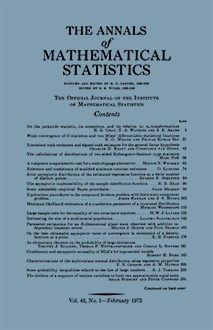Abstract
This paper attempts to add to the existing understanding of weighing designs (WD). Let us suppose that $n$ objects are to be weighed in $n$ weighings with a chemical balance having no bias. In the previous papers [14], [15], for odd $n$, optimum weighing designs are given for some particular cases subject to the conditions, viz., (i) variances of the estimated weights are equal and (ii) the estimated weights are equally correlated. Assuming these conditions we find some more optimum designs when $n$ is odd. Throughout this paper $n$ is assumed to be odd, except in Section 4, where $n$ may take any value. Let $x_{ij} = 1$ if the $j$th object is placed in the left pan in the $i$th weighing $= -1$ if the $j$th object is placed in the right pan in the $i$th weighing $= 0$ if the $j$th object is not weighed in the $i$th weighing. The $n$th order matrix $X = ((x_{ij}))$ is known as the design matrix. Also let $y_i$ be the result recorded in the $i$th weighing, $\epsilon_i$ is the error in the result, $w_j$ the true weight of the $j$th object, so that we have $n$ equations $x_{i1}w_1 + x_{i2}w_2 + \cdots + x_{in}w_n = y_i + \epsilon_i,\quad i = 1, 2, \cdots, n.$ We assume $X$ to be a non-singular matrix. The method of least squares or the theory of linear estimation gives the estimated weights $\hat{w}$ by the equation $\hat{w} = (X'X)^{-1}X'y$ where $\hat{w}$ and $y$ are the column vectors of the estimated weights and the observations respectively. If $\sigma^2$ is the variance of each weighing, then $V (\hat{w}) = (X'X)^{-1}\sigma^2 = ((c_{ij}))\sigma^2$ where $((c_{ij}))$ is the inverse of $X'X$. The design will be called optimum in the sense of Mood, if $\det ((c_{ij}))$ ($\det$ stands for determinant) is minimum and this is the case when $\det X'X$ is maximum. The efficiency of the weighing design can be measured, in the sense of Mood, by $\det X'X/\max \det X'X$ [12]. If $\lambda_{\min}$ be the minimum characteristic root of $X'X$, then the efficiency of the design can be measured, in the sense of Ehrenfeld, by $\lambda_{\min}/\max \lambda_{\min}$ [6]. According to Kishen, the efficiency can be measured by $1/\sum c_{ii}$ [11]. The first two definitions of efficiency were first introduced by Wald in [16]. Kiefer gave some optimality criteria for experimental designs in which the three criteria mentioned above were included and discussed them fully in [9] and [10]. He named these three definitions as $D$-optimum, $E$-optimum and $A$-optimum. We use Kiefer's notations in Section 6 for the definitions of efficiency of a weighing design given above.
Citation
M. Bhaskar Rao. "Weighing Designs when $n$ is Odd." Ann. Math. Statist. 37 (5) 1371 - 1381, October, 1966. https://doi.org/10.1214/aoms/1177699281
Information





